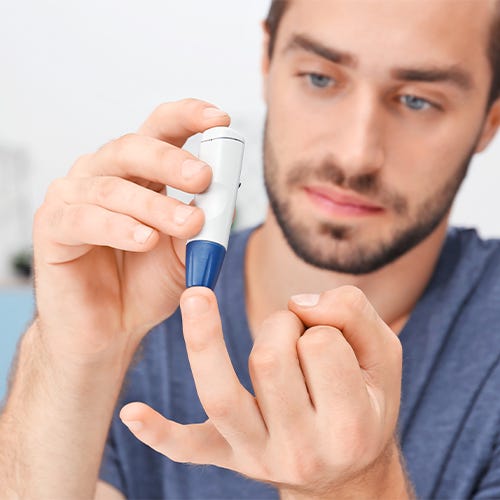Empty cart?
We can only assume that's because you haven't seen our latest offers
Sensilab uses cookies for their websites, which does not store personal data. Some cookies might already be installed. By proceeding to use this website you consent to the cookie usage.
Contact us online
100% satisfaction guarantee
Free delivery above €50
Contact us
info@sensilab.ieThe statistics are shocking; globally, approximately 1 in 3 people suffer from elevated blood sugar levels, also known as prediabetes and are unaware of all the possible complications it can have on their health.

Prediabetes is a condition that not many know about, and even fewer people worry about, even though research shows it should definitely be on our radar. But first things first, in order to understand it, we need to know what goes on in our body when blood sugar levels aren’t regulated normally.
When cells in the body don’t respond normally to insulin, this prompts the pancreas to produce more insulin to try to get cells to respond. In the long run, the functionality of the pancreas is compromised, and blood sugar rises, setting the stage for diabetes – and other health complications down the road. This condition, which often goes undiagnosed, is called prediabetes.
In short, prediabetes is characterised by elevated blood sugar levels that exceed the normal range but do not meet the criteria for a diagnosis of type 2 diabetes.
Prediabetes is often hiding under other names and abbreviations, like IGT or IFG, making it even more difficult for people to connect the dots and learn about it. Impaired glucose tolerance (IGT) refers to having elevated blood sugar levels after consuming a meal, while impaired fasting glucose (IFG) indicates higher-than-normal blood sugar levels in the morning before eating. Another indicator is a haemoglobin A1C level between 5.7% and 6.4%.
The reason this condition goes undiagnosed in so many cases is the fact that most of the time, people don’t experience any symptoms that would warn them something is going on with their body. Most of the time, prediabetes is only picked up by a doctor during a routine health check, as it can only be diagnosed with blood analysis.

Besides blood tests, a doctor may look for a combination of some other specific markers to determine whether a person has insulin resistance or not. These include waistline circumference over 102 cm for men and 88 cm for women, blood pressure higher than 130/80 and a condition called acanthosis nigricans, or the formation of dark, thick and often velvety patches on the skin. This discolouration usually occurs on elbows, knees, neck armpits and knuckles.
However, these symptoms can also be linked to any number of other problems and conditions, making them very unreliable. It’s therefore much more important to focus on the causes behind elevated blood glucose and the things that can be done to prevent it.
Prediabetes can affect anyone, but specific factors can heighten the likelihood of developing this condition. Studies** indicate a strong correlation between prediabetes and lifestyle choices as well as genetic predisposition. These are key risk factors associated with prediabetes:
While many people go years without noticing any symptoms or even downplay them, and it may take years to receive a proper diagnosis, high blood sugar levels are directly correlated to the development of diabetes. That’s why it’s imperative that we start recognising prediabetes as a serious threat to our health right now!
According to research**, if left untreated, up to 70% of individuals with prediabetes will eventually develop diabetes and other conditions such as heart disease, kidney damage, skin infections and more.
Increased glucose can be linked to the development of several serious diseases, but fortunately, we can take some steps to prevent them if we act in time.
Living with diabetes means daily checks of blood glucose levels, taking care of strict nutritional limitations and maintaining an active lifestyle.
However, caution is necessary; following a very restrictive diet and completely eliminating certain food groups may reduce the overall quality of life and prevent your body from getting all the necessary nutrients.
While managing the physical symptoms of diabetes is difficult, we should also point out that diabetes may take a huge toll on your emotional and mental well-being.
A lot of diabetic patients report** feeling frustrated and overwhelmed because they have to deal with diabetes, and this continuous battle with the condition can also develop into more serious mental problems.
In short, living with diabetes conditions every moment and every aspect of a person’s life. It doesn’t include simply taking a pill and forgetting about it; it means completely flipping one’s lifestyle upside down to manage it. That is why it is important to not wait until it’s too late but to react when there’s still time to do something about it and turn things around.
The good news is that prediabetes can often be reversed or significantly improved through simple lifestyle modifications. By incorporating small changes into our everyday routines, we can effectively stabilise blood sugar levels, improve insulin sensitivity, and reduce the risk of developing type 2 diabetes.

1. It’s all about diet
More precisely, fibre. Our number one advice is to go shopping with a detailed shopping list that includes lots of fibre-rich foods, such as fruits, vegetables, and whole grains. And while we know they are tempting, it is best to pass the shelves stacked with processed foods and sweet beverages.
2. Get up and get moving
Regular exercise is an excellent way to control body weight and manage prediabetes. Reports** suggest that losing between 5% and 7% of total body weight can lower the risk of type 2 diabetes progression by more than 58%. This can be achieved following our dietary recommendations from step one and by incorporating 30 minutes of physical activity that raises the heart rate. The simplest ways of sneaking some sport into the day without disrupting your routine too much include:
3. Cinnamon to the rescue
Cinnamon is a popular spice used all around the world to add that distinctive sweet and woody flavour with just a hint of spiciness to all kinds of dishes.
But what many people don’t know is how they can use it to their advantage to help control and balance glucose levels in a completely natural way. Cinnamon is known to have a positive impact on blood glucose levels as it delays glucose absorption in the blood, which helps prevent blood sugar spikes after meals.
And not only that! A study** has shown that long-term use of this miracle spice can reduce fasting blood glucose levels by up to 25*% in people with elevated blood sugar.
By taking these three proactive steps towards a healthier lifestyle, you can pave the way for a brighter, prediabetes-free future!

For years implementing lifestyle changes was the only way to deal with prediabetes. And while they definitely work, there is one downside to them – they take time! Switching to a healthier diet with more fibre-rich foods and eliminating sugar and carbohydrates from the menu is a gradual process that involves a lot of planning and adjustments.
And more importantly, even if you start following all the suggestions this very moment, improvement won’t be visible overnight.
But there is a solution on the horizon. After conducting extensive tests and in-depth research, scientists have finally found a way to harness the numerous beneficial properties of cinnamon.
While one might think that including this spice in the diet is the way to go, we have some bad news. As much as we like cinnamon in our apple strudel, the amount it contains is simply not high enough to benefit our well-being. We’d actually have to eat 2 teaspoons of cinnamon a day to see any positive health changes whatsoever. Besides, eating dry cinnamon powder is very dangerous as it can irritate the throat and lungs.
Dietary supplements containing cinnamon, however, contain concentrated amounts of cinnamon and are much more practical to use because they mostly come in the form of easy-to-swallow capsules.
This breakthrough in research has paved the way for our scientists to develop a remarkable food supplement that offers a safe, fast, and economical solution suitable for everyone struggling with elevated blood sugar.
In combination with some lifestyle changes, this product helps effectively lower glucose blood levels, keeps them from developing into more serious conditions, and generally improves our well-being and quality of life.
GlucoLux is a multi-action complex ideal for people who struggle with elevated blood sugar levels, want to decrease their cravings for sweets or generally want to maintain healthy blood sugar levels. Our dedicated team of nutritionists built the formulation around cinnamon, but further enriched it with other science-backed ingredients like gymnema syvestre, fenugreek, and chromium, which work in synergy with cinnamon to deliver the best results possible in lowering blood sugar levels and improving insulin sensitivity.
GlucoLux is produced by Sensilab, a leading European company in the field of dietary supplements. All our products are manufactured in a modern, state-of-the-art facility and are produced following European regulations and the highest industry standards, which are proven by the GMP quality certificate.
Recognising prediabetes in time is the most important step in protecting ourselves from developing further health complications. The good news is that prediabetes is a manageable and even reversible condition, but we have to act in time and implement some lifestyle changes if we want to be successful.
Diet and exercise are the foundation of this recipe, but the best addition that guarantees fast success is GlucoLux, a science-based dietary supplement that can reduce fasting glucose blood levels by up to 25*%, making the process of controlling prediabetes that much easier.
Due to extremely high demand, GlucoLux is flying off the shelves on the British market!
*Disclaimer: the effects of the product may vary between individuals and could differ from those described on the website. Our products are not intended to prevent, treat, or cure any disease or serious illness. Maintaining a balanced diet and a healthy lifestyle is important.
**Sources:
Safdar, Mahpara & Alam, Khan & Khattak, Muhammad Muzaffar Ali Khan & Mohammad, Siddique. (2004). Effect of Various Doses of Cinnamon on Blood Glucose in Diabetic Individuals. Pakistan Journal of Nutrition. 3. 10.3923/pjn.2004.268.272.
Tabák AG, Herder C, Rathmann W, Brunner EJ, Kivimäki M. Prediabetes: a high-risk state for diabetes development. Lancet. 2012 Jun 16;379(9833):2279-90. doi: 10.1016/S0140-6736(12)60283-9. Epub 2012 Jun 9. PMID: 22683128; PMCID: PMC3891203.
Morris RW, Taylor AE, Fluharty ME, Bjørngaard JH, Åsvold BO, Elvestad Gabrielsen M, Campbell A, Marioni R, Kumari M, Korhonen T, Männistö S, Marques-Vidal P, Kaakinen M, Cavadino A, Postmus I, Husemoen LL, Skaaby T, Ahluwalia TV, Treur JL, Willemsen G, Dale C, Wannamethee SG, Lahti J, Palotie A, Räikkönen K, McConnachie A, Padmanabhan S, Wong A, Dalgård C, Paternoster L, Ben-Shlomo Y, Tyrrell J, Horwood J, Fergusson DM, Kennedy MA, Nohr EA, Christiansen L, Kyvik KO, Kuh D, Watt G, Eriksson JG, Whincup PH, Vink JM, Boomsma DI, Davey Smith G, Lawlor D, Linneberg A, Ford I, Jukema JW, Power C, Hyppönen E, Jarvelin MR, Preisig M, Borodulin K, Kaprio J, Kivimaki M, Smith BH, Hayward C, Romundstad PR, Sørensen TI, Munafò MR, Sattar N. Heavier smoking may lead to a relative increase in waist circumference: evidence for a causal relationship from a Mendelian randomisation meta-analysis. The CARTA consortium. BMJ Open. 2015 Aug 11;5(8):e008808. doi: 10.1136/bmjopen-2015-008808. Erratum in: BMJ Open. 2015;5(9):e008808. PMID: 26264275; PMCID: PMC4538266.
Hostalek U. Global epidemiology of prediabetes - present and future perspectives. Clin Diabetes Endocrinol. 2019 May 9;5:5. doi: 10.1186/s40842-019-0080-0. PMID: 31086677; PMCID: PMC6507173.
Coleman, R. (2022, September 20). The unseen challenges of living with diabetes. RWK Goodman. https://www.rwkgoodman.com/info-hub/the-unseen-challenges-of-living-with-diabetes/
Center for Disease Control and Prevention. (2022, December 27). Why participate. Center for Disease Control and Prevention. https://www.cdc.gov/diabetes/prevention/why-participate.html
Products for you
Leaving already?
You’ve left [X] items in your cart.
We can’t guarantee the products will still be available when you return.
Check out now and get an EXTRA 10% OFF.
